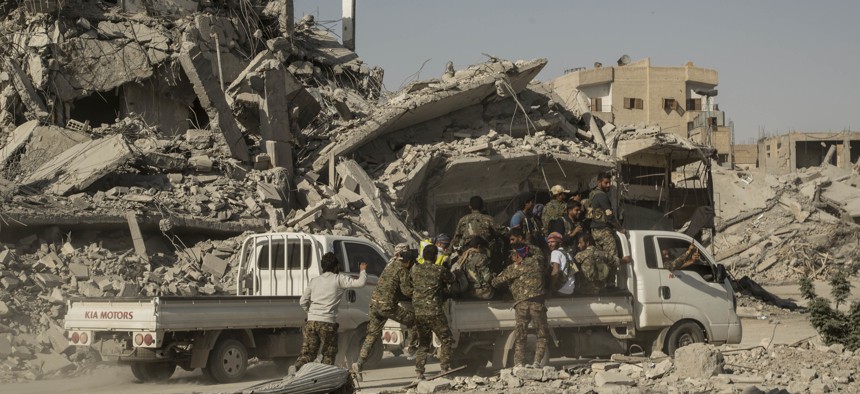
Members of the U.S.-backed Syrian Democratic Forces (SDF) ride near near the main traffic circle in Raqqa Syria, Friday, Oct. 20, 2017. AP Photo/Asmaa Waguih
Does a New US Goal for Syrian Training Portend a Longer Mission?
The military’s top general raised expectations for the Syrian Democratic Forces — and lowered them for a quick exit for U.S. troops.
Pentagon leaders have bumped up their public goal for training the Syrian Democratic Forces, which one expert called an indication of a long haul ahead for U.S. troops there.
The United States is now aiming to train up to 40,000 local troops to fight ISIS, ensure stability, and help with diplomacy, Joint Chiefs Chairman Gen. Joseph Dunford said at an event at the Washington Post on Thursday.
Asked about U.S. troops in eastern Syria, Dunford said, “we estimate that between 35,000 to 40,000 local forces need to be trained and equipped in order to provide stability. We’re probably somewhere along the line of 20 percent through the training of those forces.”
He declined to say how long U.S. troops might have to remain in Syria, saying only that the mission “still has a long way to go.”
The SDF-training goal is up from 30,000 in January, given in a statement by a spokesman for the U.S.-led coalition, U.S. Army Col. Ryan Dillon.
The new, bigger number was news to Charles Lister, a senior fellow at the Middle East Institute.
“40,000 sounds like a big number if we’re talking strictly about ‘eastern’ Syria (i.e. Deir ez Zour), so I’m not surprised if we’ve only managed to recruit and train 20 percent of that,” Lister said. “The core impetus here is to continue a process of diversifying the SDF, or more specifically, of diluting the role of Kurds and leveraging Arabs back into the forefront of determining their own security conditions and future.”
Lister said the larger number makes sense in concert with an expansion of U.S. military presence in Syria.
“Despite continuing uncertainty surrounding the President’s support for an enduring presence, expanding airfields, training bases and other facilities does not look like a force preparing to leave Syria any time soon,” he said. “Hence the natural need to recruit and train more indigenous and locally credible forces, as we’re doing in the east.”



